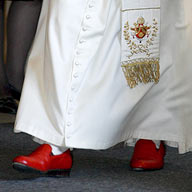Pope Benedict’s surprising resignation on Monday, February 11, — the first pope to resign in 600 years, we’re told — has, not surprisingly, unleashed a great deal of commentary, from speculation about the reasons (besides his health) to musings about the retirement of elderly leaders in general. There are tributes and assessments of his writing and achievements. Others are less willing to line up with accolades. It should not be forgotten, they say, how dreadful Pope Benedict’s record is on the sex abuse of children at the hands of church leaders.
I find the words of political commentator Andrew Sullivan (see this column also) significant on the matter of Pope Benedict’s legacy. And after all that, I caught part of the documentary “Mea Maxima Culpa: Silence in the House of God” on CBC-TV’s The Passionate Eye on Sunday evening. That night, it was hard to fall asleep.
I mean no disrespect to my dear friends who are Catholic, but in this context, I find the images one often sees of Pope Benedict’s red shoes and white robes chilling; they seem an indictment.
